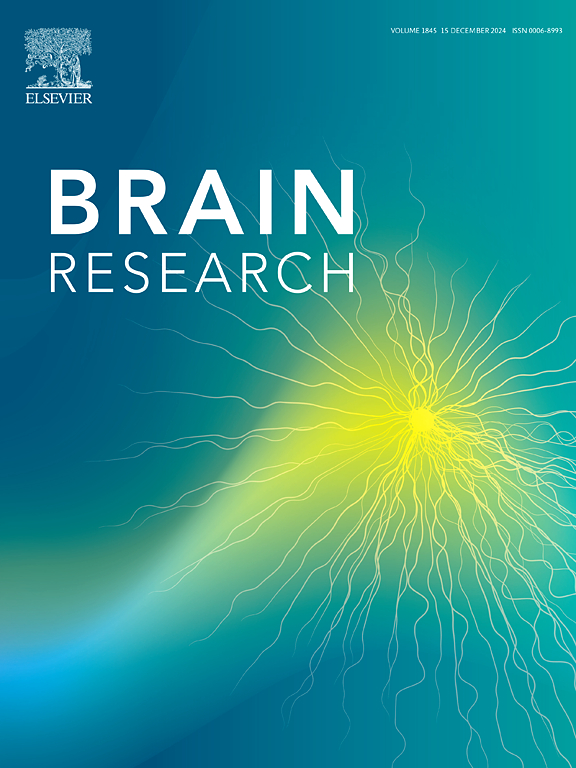Overexpressed MicroRNA-455-3p enhances cognitive function in late-onset Alzheimer’s disease
IF 2.6
4区 医学
Q3 NEUROSCIENCES
引用次数: 0
Abstract
MicroRNAs (miRNAs) are emerging as key regulators of neurodegenerative diseases, including Alzheimer’s disease (AD). miR-455-3p has been implicated in neuronal function, yet its role in cognition, motor function, and behavioral responses, in relation to AD remains unexplored. This study investigates the effects of miR-455-3p overexpression and knockout in late-onset humanized Amyloid beta (hAbKI) mouse model. We crossed miR-455-3p transgenic (TG) and knockout (KO) mice with hAbKI mice, generated double mutant mice (miR-455-3p Tg X hAbKI and miR-455-3p KO X hAbKI) and assessed cognitive behavior. To evaluate behavioral phenotype, we used cognitive and motor tests in six experimental groups—wild-type (WT), miR-455-3p KO, miR-455-3p TG, hAbKI, miR-455-3p TG X hAbKI, and miR-455-3p KO X hAbKI—to the Morris Water Maze (MWM), Y-maze, open field, and rotarod tests. miR-455-3p overexpression in TG mice significantly enhanced locomotor activity (open field test), working memory (Y-maze), hippocampal spatial learning & memory (MWM), and motor coordination (rotarod test). In contrast, miR-455-3p KO and KO X hAbKI mice exhibited impaired cognitive functionand reduced motor performance. In addition, miR-455-3p KO and KO X hAbKI mice showed increased anxiety-like behavior in the light-dark (LD) test. Notably, the hAbKI X miR-455-3p KO group displayed the most severe deficits, suggesting that the loss of miR-455-3p exacerbates AD-related impairments. Statistical analyses confirmed significant group differences (p < 0.05), with post-hoc tests demonstrating superior performance in the TG group compared to KO and hAbKI X miR-455-3p KO mice. These findings suggest that miR-455-3p plays a significant role in regulating cognitive and motor functions, with its overexpression conferring neuroprotective benefits. Targeting miR-455-3p may provide novel strategies for improving cognitive and motor outcomes in AD and related conditions.

过表达的MicroRNA-455-3p增强晚发性阿尔茨海默病的认知功能。
MicroRNAs (miRNAs)正在成为包括阿尔茨海默病(AD)在内的神经退行性疾病的关键调节因子。miR-455-3p与神经元功能有关,但其在AD相关的认知、运动功能和行为反应中的作用仍未被探索。本研究探讨了miR-455-3p过表达和敲除对晚发型人源化β淀粉样蛋白(hAbKI)小鼠模型的影响。我们将miR-455-3p转基因(TG)和敲除(KO)小鼠与hAbKI小鼠杂交,产生双突变小鼠(miR-455-3p TG X hAbKI和miR-455-3p KO X hAbKI)并评估认知行为。为了评估行为表型,我们在五个实验组中使用了认知、运动和焦虑样测试-野生型(WT)、miR-455-3p KO、miR-455-3p TG、hAbKI、miR-455-3p TG X hAbKI和miR-455-3p KO X hAbKI- Morris水迷宫(MWM)、y迷宫、开阔场、旋转路和光暗箱(LD)测试。TG小鼠中miR-455-3p过表达显著增强了运动活动(开场试验)、工作记忆(y型迷宫)、海马空间学习记忆(MWM)和运动协调(旋转杆试验)。相比之下,miR-455-3p KO和KO X hAbKI小鼠在LD测试中表现出认知功能受损、运动表现下降和焦虑样行为增加。值得注意的是,hAbKI X miR-455-3p KO组表现出最严重的缺陷,这表明miR-455-3p的缺失加剧了ad相关的损伤。统计分析证实组间差异显著(p
本文章由计算机程序翻译,如有差异,请以英文原文为准。
求助全文
约1分钟内获得全文
求助全文
来源期刊

Brain Research
医学-神经科学
CiteScore
5.90
自引率
3.40%
发文量
268
审稿时长
47 days
期刊介绍:
An international multidisciplinary journal devoted to fundamental research in the brain sciences.
Brain Research publishes papers reporting interdisciplinary investigations of nervous system structure and function that are of general interest to the international community of neuroscientists. As is evident from the journals name, its scope is broad, ranging from cellular and molecular studies through systems neuroscience, cognition and disease. Invited reviews are also published; suggestions for and inquiries about potential reviews are welcomed.
With the appearance of the final issue of the 2011 subscription, Vol. 67/1-2 (24 June 2011), Brain Research Reviews has ceased publication as a distinct journal separate from Brain Research. Review articles accepted for Brain Research are now published in that journal.
 求助内容:
求助内容: 应助结果提醒方式:
应助结果提醒方式:


